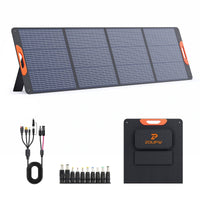Have you ever checked your solar panel’s display or power station input and wondered:
"Why is it only showing 160W when I bought a 200W panel?"
Don’t worry — your panel isn’t defective. In fact, this is completely normal. Here's why.
🌞 Rated Power vs. Real Output: What’s the Difference?
First, we need to understand the difference between the solar panel's rated output power and the actual charging power.
🔧 Rated Power (Also called "Nominal Power")
The maximum continuous power a device is designed to deliver or handle under ideal, standardized conditions.For a solar panel, it's measured under STC (Standard Test Conditions):
- 1000W/m² solar irradiance
- temperature of 77°F/25°C
- Air mass of 1.5
This is an idealized testing environment and may significantly differ from actual usage conditions.
Output Power (Also called "Real-World Output")
This is the actual power your panel generates in real-time, which depends on weather, angle, temperature, and more.For example, a 200W rated solar panel might only produce 160W or less on a cloudy day.
Nominal output power is directly proportional to the power and quantity of solar cells used in the solar panel. Therefore, different models of solar panels may have different nominal output powers, and there is no direct one-to-one relationship with actual charging power.
Why Is My Solar Panel Output Lower Than the Rated Power?
The actual output power lower than its rated power due to several factors:
Actual charging power is influenced by multiple factors, including the output parameters of the controller, sunlight intensity, the orientation and angle of the solar panel, environmental temperature, air mass, charging protocols, cable quality, and the maximum charging power supported by the connected devices.
Solar Irradiance:
In real conditions, sunlight intensity is often lower due to cloud cover, time of day, or geographical factors, leading to reduced output.
Temperature:
Solar panels lose efficiency as their temperature rises. High temperatures cause a decrease in output power, as most panels have a negative temperature coefficient, meaning their output decreases as the temperature increases.
Angle and Orientation:
If the panel is not positioned to directly face the sun or at the optimal angle, it will receive less sunlight, resulting in lower output.
Place the solar panel in direct sunlight. Adjust its angle to ensure the sunlight is perpendicular to the panel's surface for optimal charging efficiency.
Shading:
Even partial shading (from trees, buildings, etc.) can significantly reduce a panel's output, as it affects the entire panel's performance.
Panel Aging:
Over time, solar panels degrade, and their efficiency decreases. Typically, panels retain around 80% of their original output after 25 years.
Power Station Input Limit:
Many portable power stations have a max solar input limit. If your power station can only take 100W, it won’t accept more, even if the solar panel is rated at 200W.So before purchasing solar panels, make sure to check your power station's specifications.
Efficiency Losses:
Energy loss happens during conversion. The MPPT controller in the power station, wiring, and connections all cause some loss, Additionally, if you use an extension cable, a longer cable will cause some power loss.
Voltage & Current Mismatch:
If the solar panel’s voltage or current doesn’t match the power station’s input specs, the MPPT controller won’t be able to optimize power conversion, leading to lower actual input.
What You Can Do to Maximize Output
When your electronic device is charging slowly or not charging, you should check the following points:
- Please check the environment and weather. Electricity generation may be reduced or disrupted during cloudy or rainy conditions.
- Confirm that the solar panel is oriented towards direct sunlight. Adjust its position to ensure sufficient sunlight exposure on the surface.

- Please check if the output cable is properly plugged in or if there are any defects or loose connections. Try reconnecting the output cable.
- Please inspect the surface of the solar panel for any obstructions. Remove any obstacles if present.
- Please check if your charging device is overheating. Some devices may automatically adjust their charging power or even pause charging based on temperature conditions. In such cases, please pause using the device or shut it down, wait for it to cool down, and then resume charging.
- Additionally, some devices may accept different power levels at various stages of charging (for example, some appliances may reduce charging power when the battery level exceeds 50% to protect the battery).
📢 Still have questions?
Reach out to our support team for help with panel placement, angle adjustment, or compatibility with your power station.





